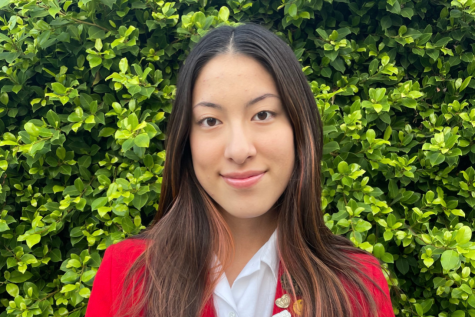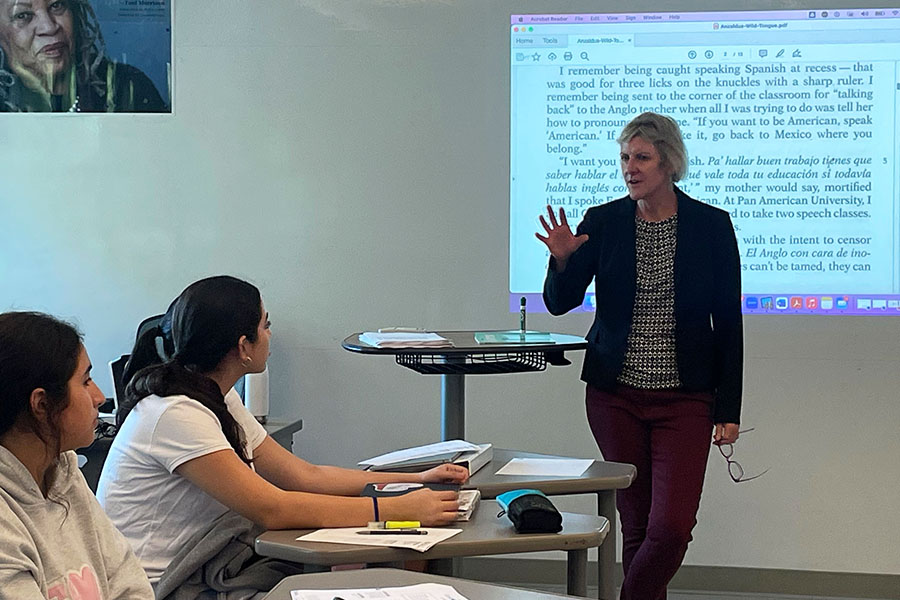Teaching students social justice remains essential to education
Dr. Amara Gero teaches about queer Chicana feminist Gloria Anzaldúa in her sophomore English class.
As I looked up from my laptop and glanced at the board, an overwhelming sense of excitement flooded my body. It was my junior year, about an hour to the lunch bell, and I was sitting in AP Language and Composition. My teacher, Dr. Amara Gero, had just turned on the Smartboard to reveal the title of her Google Slides presentation: Queer Theory. Despite identifying as queer myself, I had never known of the topic’s existence, and I had very minimal, if any, experience studying LGBTQ+ issues in the classroom. I instantly perked up, invigorated by this new concept.
Despite the lesson’s illuminating nature, it was not the intersection of queer theory and rhetorical arguments that most shocked me. Rather, it was the fact that we actually spent class time discussing a topic like this.
Whether it be LGBTQ+ issues or subjects like income disparities, racial discrimination, voting rights or gender equality, social justice topics play a prominent role in our everyday lives. We hear the term ‘social justice’ on the news, across social media platforms and in our conversations with others, but what does it actually mean?
Social justice is defined as “the fair distribution of wealth and opportunities within a society”. Social justice work is critical in providing every single person with equal rights and opportunities, and it remains of the utmost importance particularly now during the U.S. midterm election season.
With social justice being at the center of many current events topics, such as the recent anti-LGBTQ+ legislative proposals, critical race theory debates or even banned literature controversies, it is imperative that high school students receive a wide-ranging education regarding these issues.
Incorporating social justice topics into the classroom has an advantageous effect on student learning because it promotes a comprehensive understanding of our society and aids in creating a safe space for people in marginalized communities. It also prepares students to build the social and navigational skills necessary for college, the workplace and later life.
Some may argue that teaching social justice inside the classroom is too political of a subject, that it’s a form of indoctrination or that it teaches students to feel guilty about having privilege.
It’s an undeniable reality, however, that bias and disparities in opportunities exist in our society. If teachers aim to teach truth in history classes and discuss current events, it would be a mistake to omit the teaching of social justice topics, as they are part of many people’s lived realities. Ignoring topics such as implicit bias, systemic racism or LGBTQ+ history would only weaken a student’s education. The better alternative would be to present students with multiple perspectives to aid them in further developing their own opinions.
Ms. Cassandra Gonzales, Flintridge Sacred Heart’s director of Diversity, Equity and Inclusion, believes that including social justice in the curriculum is necessary, especially on the Hill.
“Human dignity is not partisan, especially at a Catholic school where supporting human dignity and believing in everyone’s inherent value is part of the mission,” Gonzales said.
Including social justice in school curriculums allows students to understand the reality of the world we live in. In a 2021 article written for NAFSA: Association of International Educators, writer Karen Doss Bowman stresses the importance of social justice pedagogy.
“We live in a globalized society, and we live in a society that is steeped in injustices and inequities,” Bowman said. “Both constructs are really important to infuse throughout the curriculum, and without doing that, we’re doing a disservice to our students.”
Having a better understanding of society’s injustices helps students to become knowledgeable and active members of their communities, especially those from private schools, where students tend to have a higher level of privilege compared to those in public schools.
“Including social justice in the curriculum here is necessary so that we’re not just living in this bubble,” Gonzales said. “And that’s not really specific to FSH so much as independent schools.”
A key aspect of working toward social justice is acknowledging and addressing the injustices present in history, especially those that affect marginalized groups. Teaching these stories remains crucial to gaining a holistic view of how our society came to be.
“To avoid [injustices] is almost like another way of saying that these things didn’t happen,” Sae Zhang ‘23 said. “Brushing over these subjects, especially in government, American history or European history classes is simply erasing what’s been done in the past.”
Covering social justice topics in the classroom can additionally benefit students who identify as members of marginalized groups. When students learn about cultures and backgrounds that vary from their own, it becomes easier for them to appreciate those that differ from them in their everyday lives. Teaching students about inequities will also facilitate empathy, helping them understand the importance of respecting people in different marginalized communities.
“I intentionally select stories that represent a variety of intersectional identities and lived experiences,” Dr. Gero said. “I think it is of critical importance that students are exposed to a wide range of narratives that represent different perspectives and walks of life in order to develop empathy towards others.”
Educating students about diversity, equity and inclusion will promote a respectful learning environment that is vital to every student’s well-being. Fostering these thoughtful environments is critical to student success, both in and outside the classroom. For example, when queer students are exposed to positive examples of LGBTQ+ representation, their emotional health in the classroom improves.
“Research shows that [students] are more engaged…have more interest in education, have better mental health and a higher sense of belonging,” Gonzales said.
One of the primary purposes of education in our society is to prepare students for their future endeavors, whether that be further schooling, their careers or their later life in general. Social justice instruction can help create a learning environment where students can best develop their skill sets, by means of curating collaborative and safe communities. Additionally, discussing social justice subjects can require a certain amount of critical thinking, which is vital to developing personal viewpoints.
“If we discuss [social justice] in the classroom, we’re able to make informed opinions on things,” Mia Murillo ‘23 said.
Social justice instruction can often lead to participation in real-world activities such as volunteering, which can be a great educational opportunity.
“There’s a lot of benefits to students being able to have those conversations in class and then being able to apply that to the actual action,” Ms. Alexis Salazar, FSH Religious Studies teacher said. “They can learn more about themselves, their leadership skills will grow and their community building will grow.
Thinking back to that moment in my AP Lang class, I recall my shock at the lesson for the day. The more I think about it, however, the more I am surprised that social justice isn’t a more prevalent topic featured in our curriculum, as it strengthens the quality of education and supports student wellbeing. Although unexpected at the time, that moment marked when I began regarding social justice teaching as something necessary and something that should always be expected.

Graciela Tiu is a senior and an associate editor for the Veritas Shield. She began working for the paper in her junior year, and she plans to continue...


